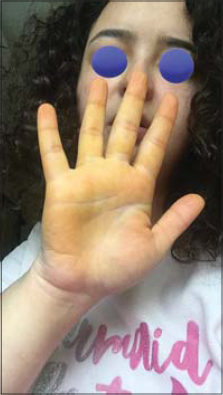Did you say yellow palm ?
Selma El Kadiri , Zakia Douhi, Rhizlane Chaoui, Sara Elloudi, Hanane Baybay, Fatima Zahra Mernissi
, Zakia Douhi, Rhizlane Chaoui, Sara Elloudi, Hanane Baybay, Fatima Zahra Mernissi
Department of Dermatology and Venereology, University Hospital Hassan II, Fez, Morocco
Corresponding author: Dr. Selma El Kadiri
Submission: 27.04.2020; Acceptance: 24.06.2020
DOI: 10.7241/ourd.2020e.67
Cite this article: El Kadiri S, Douhi Z, Chaoui R, Elloudi S, Baybay H, Mernissi FZ. Did you say yellow palm ? Our Dermatol Online. 2020;11(e):e67.1
Citation tools:
Copyright information
© Our Dermatology Online 2020. No commercial re-use. See rights and permissions. Published by Our Dermatology Online.
Sir,
A 24-year-old woman presented with orange discoloration of right palm that had begun one-day before (Fig. 1). The rest of her skin, sclera, and other mucous membranes were normally colored. She had no history of alimentary disturbance. She didn’t report any abdominal symptoms or modification in the color of her urine. She had eaten a large number of tomatoes and spinach for the last 2 days. She didn’t take any energy drinks. Blood examination including, She was advised to reduce the amount of spinach and tomatoes. The discoloration had faded several days after.
 |
Figure 1: Yellow discoloration of the right palm. |
Carotenoderma is a yellowish discoloration of the skin especially of the palms, soles, and central face which is sometimes seen in diabetic patients and patients with trisomy 21 [1]. It is more common in children and is not associated with the ingestion of carrots. It can be induced by oranges, squash, spinach, yellow corn, butter, eggs, pumpkin, yellow turnips, sweet potatoes, mango, and dried seaweeds. An excess intake of lycopene-rich foods (tomato, papaya) may induce lycopenemia and skin findings similar to carotenoderma. It is clinically apparent when serum carotene levels are three to four times normal [2]. The discoloration spares the sclera and mucosal surfaces, which can be used to differentiate this benign condition from jaundice. Elimination of the offending food results in normalization of skin color in 2 to 6 weeks. Carotenemia also occurs in diabetes mellitus and hypothyroidism due to impaired hepatic conversion of carotene to vitamin A. It has been reported in anorexia nervosa with undetermined etiology [3].
Consent
The examination of the patient was conducted according to the Declaration of Helsinki principles.
The authors certify that they have obtained all appropriate patient consent forms. In the form the patient(s) has/have given his/her/their consent for his/her/their images and other clinical information to be reported in the journal. The patients understand that their names and initials will not be published and due efforts will be made to conceal their identity, but anonymity cannot be guaranteed.
REFERENCES
1. Priyadarshani AMB. Insights of hypercarotenaemia:A brief review. Clin Nutr ESPEN. 2018;23:19-24.
2. Korsaga/SoméN, Zoungrana/Ouédraogo A, KonatéI, Ouédraogo/Ouédraogo M, Patrice Tapsoba G, Sosso-Kargougou N, et al. [Skin disorders in preschool environment in the city of Ouagadougou (Burkina Faso):Epidemiological, clinical and therapeutic aspects]. Our Dermatol Online. 2019;10:e31.1-e31.8.
3. Ahluwalia J, Yan AC. Carotenoderma associated with a diet rich in red palm oil. Cutis. 2018;101:E4-E5.
Notes
Source of Support: Nil,
Conflict of Interest: None declared.
Request permissions
If you wish to reuse any or all of this article please use the e-mail (brzezoo77@yahoo.com) to contact with publisher.
| Related Articles | Search Authors in |
|
 http://orcid.org/000-0003-3455-3810 http://orcid.org/000-0003-3455-3810 |



Comments are closed.